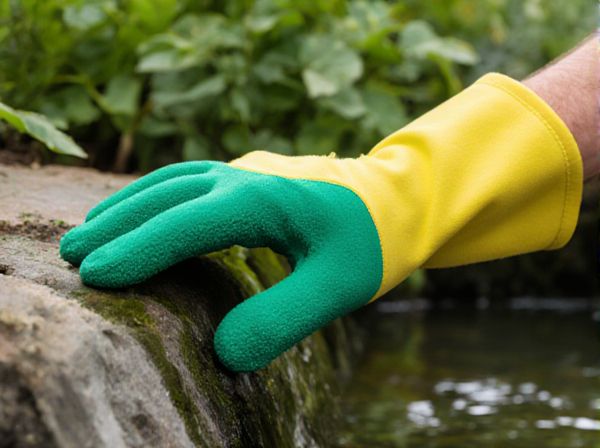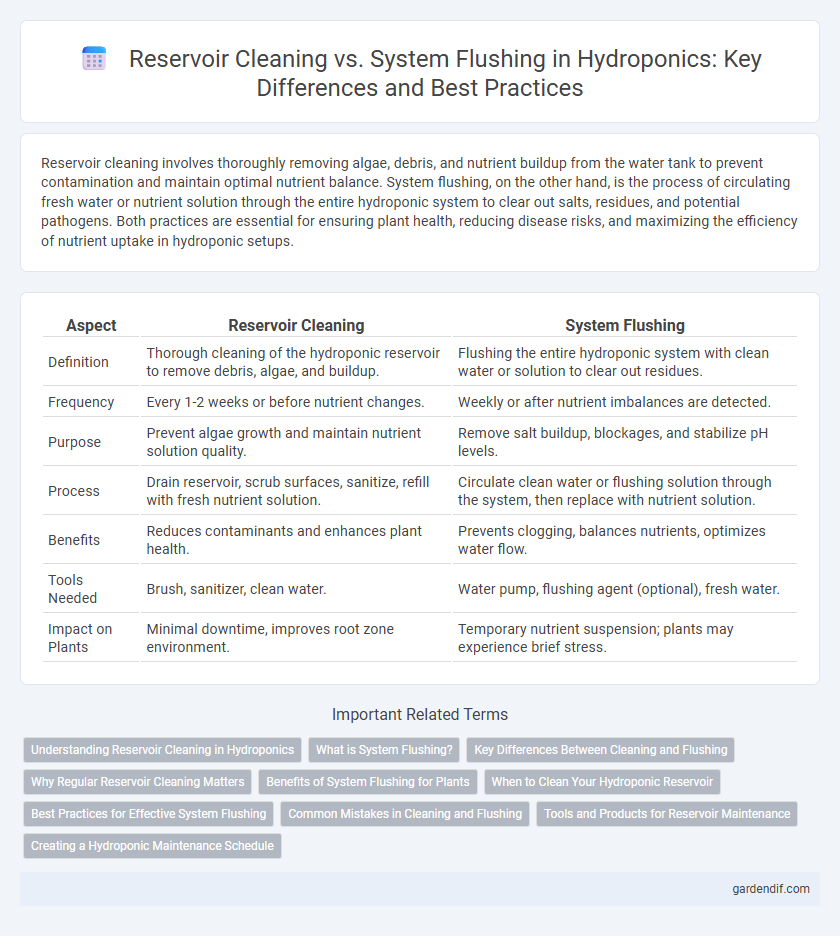
Reservoir Cleaning vs System Flushing Illustration
Reservoir cleaning involves thoroughly removing algae, debris, and nutrient buildup from the water tank to prevent contamination and maintain optimal nutrient balance. System flushing, on the other hand, is the process of circulating fresh water or nutrient solution through the entire hydroponic system to clear out salts, residues, and potential pathogens. Both practices are essential for ensuring plant health, reducing disease risks, and maximizing the efficiency of nutrient uptake in hydroponic setups.
Table of Comparison
| Aspect | Reservoir Cleaning | System Flushing |
|---|---|---|
| Definition | Thorough cleaning of the hydroponic reservoir to remove debris, algae, and buildup. | Flushing the entire hydroponic system with clean water or solution to clear out residues. |
| Frequency | Every 1-2 weeks or before nutrient changes. | Weekly or after nutrient imbalances are detected. |
| Purpose | Prevent algae growth and maintain nutrient solution quality. | Remove salt buildup, blockages, and stabilize pH levels. |
| Process | Drain reservoir, scrub surfaces, sanitize, refill with fresh nutrient solution. | Circulate clean water or flushing solution through the system, then replace with nutrient solution. |
| Benefits | Reduces contaminants and enhances plant health. | Prevents clogging, balances nutrients, optimizes water flow. |
| Tools Needed | Brush, sanitizer, clean water. | Water pump, flushing agent (optional), fresh water. |
| Impact on Plants | Minimal downtime, improves root zone environment. | Temporary nutrient suspension; plants may experience brief stress. |
Understanding Reservoir Cleaning in Hydroponics
Reservoir cleaning in hydroponics involves thoroughly removing algae, biofilm, and mineral deposits from the water storage container to maintain optimal nutrient uptake and prevent pathogen buildup. Regular cleaning of the reservoir ensures balanced pH levels and reduces the risk of root diseases caused by stagnant or contaminated water. This process is crucial for sustaining healthy plant growth and maximizing hydroponic system efficiency.
What is System Flushing?
System flushing in hydroponics involves circulating clean water or a flushing solution through the entire system to remove accumulated salts, nutrients, and contaminants that can inhibit plant growth. This process targets the nutrient film technique, pipes, and growing media to prevent blockages and maintain optimal oxygen levels at the root zone. Regular system flushing improves nutrient uptake, reduces root diseases, and enhances overall plant health compared to reservoir cleaning alone.
Key Differences Between Cleaning and Flushing
Reservoir cleaning involves physically removing algae, debris, and biofilm buildup from the water storage container to prevent contamination and ensure nutrient solution quality. System flushing focuses on circulating clean water or flushing agents through the entire hydroponic system's pipes and channels to eliminate accumulated salts and prevent blockages. The key difference lies in reservoir cleaning targeting the storage unit's hygiene, while system flushing aims to maintain overall nutrient flow and system performance.
Why Regular Reservoir Cleaning Matters
Regular reservoir cleaning in hydroponic systems prevents the buildup of harmful pathogens, algae, and mineral deposits that can impair nutrient absorption and plant growth. It ensures the water quality remains optimal by eliminating contaminants and maintaining balanced pH and nutrient levels, which are critical for healthy root development. Clean reservoirs reduce the risk of system blockages and extend the lifespan of equipment, promoting overall system efficiency and crop yield.
Benefits of System Flushing for Plants
System flushing removes accumulated salts and nutrients from the hydroponic environment, promoting healthier root development and enhancing nutrient uptake efficiency. This process prevents the build-up of harmful residues that can stress plants and reduce growth rates. Regular system flushing supports consistent pH levels and oxygen availability, ensuring optimal plant health and maximizing crop yield.
When to Clean Your Hydroponic Reservoir
Hydroponic reservoirs should be cleaned every 1 to 2 weeks to prevent nutrient buildup and algal growth, ensuring optimal plant health and system efficiency. System flushing is recommended during nutrient changes or when pH and EC levels fluctuate significantly, helping to maintain stable growing conditions and prevent root disease. Regular reservoir cleaning and timely flushing reduce the risk of pathogens and improve oxygen availability for roots, maximizing crop yield.
Best Practices for Effective System Flushing
Effective system flushing in hydroponics involves regularly circulating clean, pH-balanced water through the entire setup to remove nutrient residues and prevent algae buildup. Maintaining a schedule for flushing every two to four weeks enhances nutrient uptake efficiency and reduces the risk of root diseases caused by stagnant water. Using appropriate flushing agents and monitoring electrical conductivity (EC) ensures optimal system performance and prolongs the life of pumps and tubing.
Common Mistakes in Cleaning and Flushing
Common mistakes in hydroponic reservoir cleaning include neglecting to remove all organic debris, which fosters algae growth and pathogens, and failing to use appropriate disinfectants that can damage plant roots or beneficial microbes. System flushing errors often involve insufficient flushing duration or inadequate water pressure, leading to the accumulation of nutrient salts and biofilm in pipes, reducing nutrient uptake efficiency. Overlooking these issues results in reduced crop yields and increased risk of plant diseases in hydroponic setups.
Tools and Products for Reservoir Maintenance
Effective reservoir cleaning in hydroponic systems requires specialized brushes, non-abrasive scrubbers, and food-safe cleaning agents designed to remove algae, biofilms, and mineral buildup without harming plants. System flushing employs nutrient flush solutions and pH-neutral cleansers to eliminate excess salts and prevent nutrient imbalances, ensuring optimal root health and water quality. Using dedicated reservoir cleaning kits and biofilm-specific products enhances maintenance efficiency, prolonging equipment lifespan and promoting consistent crop yields.
Creating a Hydroponic Maintenance Schedule
Regular reservoir cleaning removes sediment, biofilm, and pathogens that accumulate in hydroponic systems, preventing root diseases and ensuring optimal nutrient absorption. System flushing involves periodically draining and refilling the entire setup with fresh nutrient solution, maintaining balanced pH and electrical conductivity levels essential for plant health. Creating a hydroponic maintenance schedule that includes both reservoir cleaning every 1-2 weeks and system flushing every 3-4 weeks maximizes water quality and promotes consistent crop yields.
Reservoir Cleaning vs System Flushing Infographic

 gardendif.com
gardendif.com